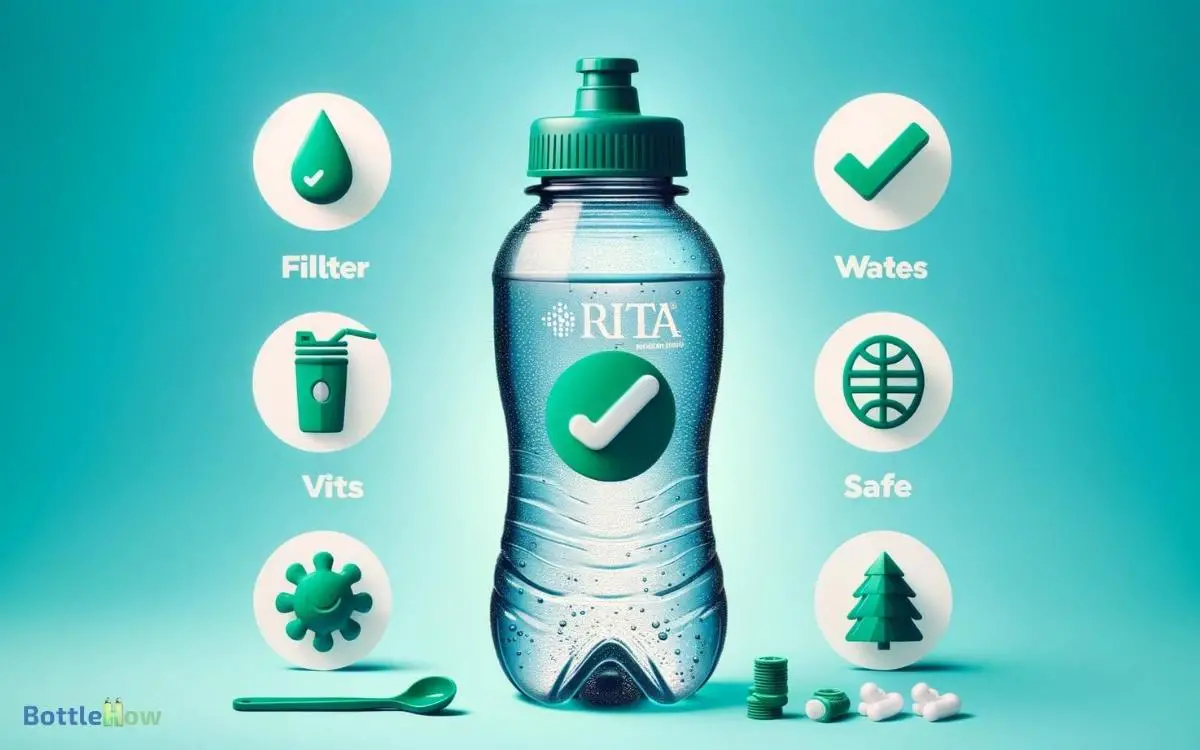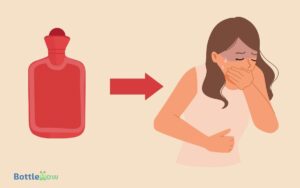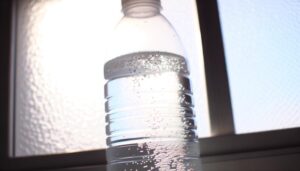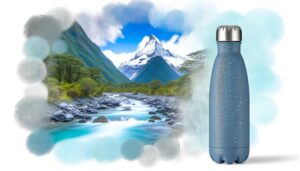Can You Use Brita Water Bottle Without Filter? Yes!
You can use a Brita water bottle without the filter, but it defeats the purpose of improving water quality.
The activated carbon and ion-exchange resin in Brita filters remove contaminants like chlorine and lead.
Without the filter, you might taste chlorine and other impurities, and health risks from unfiltered water could arise.
The Brita bottle itself is durable, BPA-free, and convenient, but without filtration, water quality can suffer.
To understand the implications of using the bottle without its filter and explore cost-effective alternatives, continue.

Key Takeaways
Understanding Brita Water Bottles
Brita water bottles are designed to provide on-the-go filtration, ensuring you have access to clean drinking water wherever you are.
These bottles utilize a built-in filtration system that removes impurities from tap water, such as chlorine and particulates.
Constructed from durable, BPA-free materials, Brita water bottles are engineered for both functionality and safety.
The ergonomic design includes a spill-proof lid and a convenient carrying loop, making it ideal for active lifestyles. Additionally, the bottles are dishwasher safe, simplifying maintenance.
While Brita bottles are optimized for use with their filters, you can still use them without one, though you won’t benefit from the filtration capabilities. Their robust construction and thoughtful design make them versatile, even without the filter.
How Brita Filters Work
You need to understand how Brita filters function to appreciate their impact.
Brita filters use activated carbon and ion-exchange resin to remove contaminants like chlorine, lead, and particulates.
This process guarantees your water is both clean and tastes better.
Filtration Process Explained
Ever wondered how activated carbon and ion-exchange resin transform ordinary tap water into something cleaner and better-tasting?
Activated carbon possesses a large surface area, effectively adsorbing chlorine, volatile organic compounds (VOCs), and other contaminants.
Meanwhile, ion-exchange resin targets heavy metals like lead and copper, replacing them with harmless ions such as sodium. This dual mechanism guarantees you’re drinking water free from impurities.
Here’s a quick breakdown:
| Component | Function |
|---|---|
| Activated Carbon | Adsorbs chlorine, VOCs, and unpleasant odors |
| Ion-Exchange Resin | Replaces heavy metals with harmless ions |
| Pre-Screen | Filters out larger particles and sediments |
| Post-Filter | Ensures no carbon particles enter your drinking water |
Key Components Overview
Understanding the filtration process is just the beginning; now let’s examine the key components that make Brita filters effective at purifying your water.
Brita filters utilize activated carbon and ion-exchange resin to remove impurities. The activated carbon, derived from coconut shells, traps contaminants like chlorine, lead, and volatile organic compounds (VOCs) through adsorption.
Meanwhile, the ion-exchange resin targets heavy metals such as copper, cadmium, and zinc, replacing them with harmless ions like sodium and potassium.
These components work synergistically to reduce unpleasant tastes and odors, ensuring cleaner, safer water.
Additionally, the filter housing is engineered to maximize water contact time with the filtration media, enhancing overall efficiency.
By understanding these components, you can appreciate how Brita guarantees superior water quality.
Benefits of Using the Bottle Alone
Using a Brita water bottle without the filter offers the convenience of a durable, reusable container while guaranteeing the need for filter replacements.
The high-grade BPA-free plastic guarantees safety and longevity, reducing plastic waste compared to single-use bottles.
Its ergonomic design provides ease of use during physical activities, and the spill-resistant lid enhances portability.
Without a filter, the bottle’s capacity increases, allowing you to carry more water. This makes it ideal for environments where filtered water isn’t necessary.
Additionally, the bottle’s wide mouth facilitates easy cleaning and quick refilling. You’ll find it cost-effective since you won’t need to purchase replacement filters. Overall, using the Brita bottle alone provides a practical, eco-friendly hydration solution.
Potential Downsides
Using a Brita water bottle without its filter can notably reduce water quality due to the absence of contaminant removal. You might notice unfiltered taste issues, as impurities and particulates remain in the water.
Additionally, there are health safety concerns, particularly if the water source contains harmful bacteria or chemicals not mitigated by the filtration process.
Reduced Water Quality
Without the filter, the Brita water bottle fails to remove contaminants like chlorine, lead, and microbial cysts, which can compromise water quality and your health.
Chlorine exposure can irritate your skin and eyes, while lead ingestion is linked to severe neurological damage and developmental issues.
Microbial cysts, including Giardia and Cryptosporidium, pose risks of gastrointestinal illness. The filtration system is designed to eliminate these harmful substances, ensuring safer drinking water.
Without it, you’re basically consuming untreated tap water, which may not meet safety standards.
Studies show that unfiltered water often contains higher levels of pollutants, making the filter an essential component for maintaining water purity. Ultimately, using the Brita water bottle without its filter negates its primary health benefits.
Unfiltered Taste Issues
In addition to compromised water quality, you’ll likely notice a significant difference in taste when using a Brita water bottle without its filter.
The filter primarily removes chlorine and other particulates that contribute to undesirable flavors. Without it, tap water may retain a metallic or chemical taste, making it less palatable.
Laboratory analyses show that unfiltered water often contains higher levels of dissolved solids, which can lead to a more pronounced, often unpleasant, taste profile.
Furthermore, the absence of filtration means that organic compounds, which can impart earthy or musty flavors, remain present.
As a result, if taste is a priority, utilizing the filter is essential for achieving the clean, crisp water that Brita promises.
Health Safety Concerns
Neglecting to use a filter in your Brita water bottle raises important health safety concerns due to the potential presence of contaminants like lead, bacteria, and other harmful substances. Unfiltered water can harbor microorganisms, increasing the risk of gastrointestinal infections.
Lead, often found in old plumbing systems, poses a severe risk, particularly to children and pregnant women, leading to developmental issues and neurological damage.
Additionally, volatile organic compounds (VOCs) present in some water supplies can cause long-term health problems, including liver and kidney damage.
Utilizing a Brita filter greatly reduces these dangers by removing up to 99% of such contaminants.
Hence, it’s essential to always use a filter to ensure the water you consume is safe and free of harmful elements.
Comparing Water Taste
When comparing the taste of water from a Brita bottle sans filter to tap water, you’ll often notice a slight difference in flavor profile due to the absence of the activated carbon filtration process.
Without the filter, the Brita bottle won’t remove chlorine, volatile organic compounds (VOCs), or other impurities that can affect taste. Tap water might have a metallic or chemical taste depending on your local water supply.
The activated carbon filter in a Brita bottle absorbs and reduces these contaminants, leading to a cleaner, more neutral taste.
By omitting the filter, you’re basically drinking unmodified tap water, which may not offer the same level of palatability that many Brita users prefer.
This difference is subtle but noticeable to discerning taste buds.
Safety Considerations
When using a Brita water bottle without a filter, you need to be aware of the drinking water quality in your area.
Without the filter, potential contaminants like chlorine, lead, and other impurities may remain in the water.
Always follow the manufacturer’s usage guidelines to minimize health risks and guarantee safe hydration.
Drinking Water Quality
Evaluating the safety of drinking water from a Brita bottle without a filter requires understanding the source water’s quality and potential contaminants.
You need to take into account factors such as mineral content, bacterial presence, and chemical pollutants.
When evaluating water quality, it is crucial to refer to empirical data and standards established by health organizations.
| Parameter | Acceptable Levels |
|---|---|
| Total Dissolved Solids (TDS) | < 500 mg/L |
| pH Level | 6.5 – 8.5 |
| Bacterial Count | 0 CFU/100mL |
| Lead | < 0.015 mg/L |
Regular testing of your water source can provide insight into its safety. Without a filter, you might be exposing yourself to harmful substances that a Brita filter would typically reduce or eliminate. Always make sure your source water meets safety standards before consumption.
Potential Contaminants Risks
Identifying potential contaminants in your drinking water is essential to understanding the risks associated with using a Brita water bottle without a filter.
Contaminants like lead, chlorine, and microbial pathogens pose significant health risks. Lead can leach from old plumbing systems, causing neurotoxicity, particularly in children.
Chlorine, while useful for disinfection, can produce harmful byproducts like trihalomethanes (THMs), associated with cancer.
Microbial pathogens such as E. coli and Giardia can lead to severe gastrointestinal illnesses.
Without a filter, your Brita water bottle won’t remove these contaminants, potentially exposing you to these dangers.
It’s critical to assess your local water quality reports to determine if unfiltered tap water is safe for consumption. Your health depends on it.
Manufacturer’s Usage Guidelines
The manufacturer’s guidelines for using a Brita water bottle emphasize the importance of the filter’s role in guaranteeing safe and clean drinking water.
They specify that the filter is designed to reduce contaminants such as chlorine, particulates, and certain heavy metals.
Without the filter, you’re at risk of ingesting these substances, which could compromise your health. Brita’s design integrates the filter to operate effectively, ensuring each sip is purified.
Ignoring these guidelines means you’re not utilizing the bottle as intended, which could lead to exposure to harmful contaminants.
The manufacturer strongly advises replacing the filter regularly to maintain peak performance.
Adhering to these guidelines ensures you receive the maximum benefit from your Brita bottle, safeguarding your health.
Alternative Filter Options
Several alternative filter options can provide you with clean and safe drinking water when using a Brita water bottle without its original filter. These alternatives guarantee effective filtration and compatibility.
Here are four viable options:
- LifeStraw Personal Water Filter: Uses advanced microfiltration, removing 99.999% of waterborne bacteria.
- Sawyer Mini Water Filtration System: Incorporates a 0.1-micron absolute filter, ideal for removing harmful pathogens.
- Grayl Ultralight Water Purifier: Employs electroadsorptive media and activated carbon to purify water.
- Katadyn BeFree Water Filtration System: Features a 0.1-micron hollow fiber filter, perfect for outdoor use.
Each option utilizes unique filtration technology to ensure you receive potable water, maintaining your hydration needs while ensuring safety. Evaluate these options based on your specific requirements and usage scenarios.
Cost Implications
Evaluating the cost implications of using alternative filters for your Brita water bottle involves comparing initial purchase prices, long-term maintenance expenses, and the lifespan of each filter type.
Initial costs for non-Brita filters vary widely, often lower than Brita’s proprietary options. However, cheaper alternatives may require more frequent replacements due to shorter lifespans, increasing long-term costs.
Brita filters, while pricier upfront, generally offer a longer lifespan and consistent performance, potentially reducing replacement frequency. Maintenance expenses also include cleaning and ensuring filter compatibility.
An evidence-based approach suggests that while alternative filters might save money initially, Brita filters could prove more cost-effective over time.
Weighing these factors will help you make an informed decision on your water filtration needs.
Environmental Impact
Evaluating the environmental impact of using a Brita water bottle without a filter involves understanding the waste reduction benefits and the sustainability of alternative filtration methods. By not using disposable filters, you contribute to less plastic waste in landfills.
However, consider these points:
- Plastic Waste: Single-use plastic bottles create substantial waste; switching to a reusable bottle mitigates this issue.
- Production Emissions: Manufacturing filters involves energy and resource consumption, impacting carbon footprints.
- Resource Use: Regularly buying filters means ongoing material use, whereas a filter-less bottle reduces this demand.
- Water Quality: Without a filter, you need to make sure your water source is safe, possibly requiring sustainable filtration alternatives like activated charcoal sticks.
These factors help you make informed decisions about your water consumption’s ecological footprint.
User Experiences
Many users report a significant reduction in plastic waste and convenience when using a Brita water bottle without the filter.
Anecdotal evidence suggests that the bottle’s ergonomic design and durable construction make it ideal for everyday use.
Users appreciate the bottle’s BPA-free plastic, which guarantees safety and minimizes environmental impact.
Additionally, the wide mouth facilitates easy cleaning and refilling, further enhancing user experience.
Some users have noted that while the absence of the filter doesn’t affect the bottle’s primary function—holding water—it does eliminate the added benefit of filtration.
However, individuals who primarily use pre-filtered or bottled water find this trade-off acceptable, citing the bottle’s portability and leak-proof design as significant advantages.
Conclusion
Using a Brita water bottle without the filter is feasible, but consider this: a single Brita filter can replace up to 300 standard 16. 9-ounce plastic bottles. That’s a significant environmental impact. By using a diy water bottle filter or opting for a Brita filter, you can reduce plastic waste and contribute to a more sustainable lifestyle. Additionally, filtered water often tastes better by reducing chlorine and other impurities. Choosing an eco-friendly solution benefits both your health and the environment.
If you opt out of the filter, you lose out on cleaner, better-tasting water and contribute more plastic waste. Weigh the benefits of filtration against the convenience of skipping it.
Ultimately, the choice hinges on your priorities for health, cost, and sustainability.






